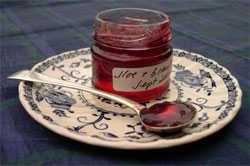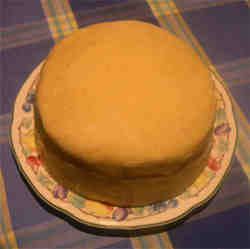Sloe and Bramley Apple Jelly Recipe
Posted by Fiona Nevile in Jam Jelly and Preserves | 110 comments
Tiny pot of sloe and apple jelly
This recipe makes a good raunchy jelly to eat with red meat, game and strong cheese. It’s also great as a sauce base for red meat, such as lamb chops. Danny usually adds a generous dollop to his pheasant casserole and dinky individual game pies, rather than adding a slug of port or sloe gin. As Sloe and Bramley Jelly has a good, strong depth of flavour it is definitely worth making a decent batch for your store cupboard. We use a bit more sugar than the usual 1pt/1lb ratio with this jelly and this seems to work well as we always use cooking apples.
Ingredients:
- 1 1/2 pounds/700g sloes, washed
- 1 1/2 pounds/700g of bramley cooking apples (ideal) or any other cooking apples. We use windfalls as they won’t keep.
- Sugar (1 UK pint/750ml/2 1/2 cups of strained juice to 1 1/2 pounds/700g of white granulated sugar, if using cooking apples. 1 pint/750ml/2 1/2 cups of strained juice to 1 pound/454g if using sweet eating apples).
Method:
- Wash the apples, cut out bad bits and chop roughly. There is no need to peel or core the apples.
Place sloes and apples in a large deep heavy bottomed saucepan, or preserving pan. - Add water to cover ½ of the fruit. Bring slowly to the boil and simmer very gently until all the fruit is soft and squishy. (This can take anything from 20 minutes to an hour, depending on how ripe the fruit is.)
- Pour the cooked fruit through sterilised muslin (how do I sterilise muslin? See tips and tricks below). The muslin is often referred to as a “jelly bag”. We use tall buckets to catch the drips from the jelly bags. Rather than hang the bags (conventional method-between two stools) I find it easier to line a large plastic sieve with the muslin. This clips neatly onto the top of a clean bucket. The sieve is covered with a clean tea cloth to protect against flies.
- Leave the jelly bag to drip overnight (or about 12 hours).
- Measure the juice the next day.
- Pour the juice into a deep heavy bottomed saucepan and add 1½ lb/700g of white granulated sugar for each 1pt/570ml of juice.
Heat the juice and sugar gently stirring from time to time, so as to make sure that that all the sugar has dissolved before bringing the liquid slowly to the boil. - Continue to boil for about 10 minutes before testing for a set. This is called a rolling boil. (What is testing for a set? See tips and tricks below).
- Tossing in a nugget of butter towards the end will reduce the frothing that can occur.
When jelly has reached setting point pour into warm sterilised jars using a funnel and ladle. (How do I sterilise jars? See tips and tricks below). - Cover immediately with plastic lined screw top lids or waxed disks and cellophane tops secured with a rubber band.
- Label when cold and store in a cool, dark place. Away from damp.
Tips and tricks:
- What is a jelly bag?
A jelly bag is traditionally a piece of muslin but it can be cheesecloth, an old thin tea cloth or even a pillowcase. The piece needs to be about 18 inches square. When your fruit is cooked and ready to be put in the jelly bag, lay your cloth over a large bowl. Pour the fruit into the centre of the cloth and tie the four corners together so that they can be slung on a stick to drip over the bowl. Traditionally a stool is turned upside down, the stick is rested on the wood between the legs and the jelly bag hangs over the bowl. We experimented and now line a sieve with muslin, place it over a bucket and cover the lot with clean tea cloths (against the flies). - How do I sterilise muslin/the jelly bag?
Iron the clean jelly bag with a hot iron. This method will also sterilise tea cloths. - Jam “set” or “setting point”?
Getting the right set can be tricky. I have tried using a jam thermometer but find it easier to use the following method.
Before you start to make the jam, put a couple of plates in the fridge so that the warm jam can be drizzled onto a cold plate (when we make jam we often forget to return the plate to the fridge between tests, using two plates means that you have a spare cold plate). Return the plate to the fridge to cool for approx two minutes. It has set when you run your finger through it and leave a crinkly track mark. If after two minutes the cooled jam is too liquid, continue to boil the jam, testing it every few minutes until you have the right set. The jam is far more delicious if it is slightly runny. - How do I sterilise the jars?
We collect jars all year round for our jelly, chutney and jam making sessions. I try to soak off labels and store the clean jars and metal plastic coated screw-top lids in an accessible place. The sterilising method that we use is simple. Just before making the jam, I quickly wash and rinse the jars and place them upside down in a cold oven. Set the temperature to 160c/140c for fan assisted. When the oven has reached the right temperature I turn off the heat. The jars will stay warm for quite a while. I only use plastic lined lids for preserves as the all-metal lids can go rusty. I boil these for five minutes in water to sterilise them. If I use Le Parfait jars, I do the same with the rubber rings.
Leave a reply






Hi Rosie,
Sometimes jelly gets a bit clearer when it has settled for a bit. I haven’t had a problem with cloudy jelly yet so don’t know what to suggest.
Someone that I know makes lots of quince jelly and always squeezes the jelly bag and his jelly is always clear.
Have just made Hedgerow Jelly – sloes, rosehips, bullace and blackberries – it seems cloudy but I definitely didn’t mash it or push it through the jelly bag1
Hi Helen,
Sloe and bramley jelly is quite a strong taste. We eat it with game and sausages. It’s good with cheese as well. You cold eat it on toast if you like the flavour but it’s not sweet like jam.
Hi Steve, You can see sloes here http://rxwildlife.org.uk/2006/08/17/blue-sloe-berries/
Hi – I’m a beginner so forgive me! I want to make some sloe gin and can’t find a picture of sloe anywhere to help me identify what I’m supposed to be picking…. can you help?
I made your blackberry and apple jelly last year (delicious) and have just made another batch this morning. Now I’m going to try the sloe and apple jelly. Could you also eat it as a jam, on toast, etc, or is it best on savoury things?
Hi LizO,
Good to hear that your jelly turned out well.
I have no specific tips for quince jelly up may sleeve. Quince jelly is my all time favourite. Ours are not quite ready yet.
I’ve just made 4lbs of Apple, Rosehip, Blackberry and Sloe jelly!! I had lots of little Lord Lamborn windfalls and couldn’t find enough of any of the other fruits on their own, however I managed to find enough as a combination.
Anyway I shall have to cook a roast at the week-end to sample the jelly. The scrapings from the pan, after I had finished bottling etc, were really delicious.
Thank heavens for Cottage Smallholders!
Tomorrow I am going to make Quince Jelly – any tips??
LizO :o)
Hi Beatrice,
The stocking will be fine. I have seen people straining through old pillowcases in the past. The point about the muslin is that it does not soak up too much of the precious juice.
Hi Irene,
I don’t mash the softened fruit before it goes into the muslin bag and I never squeeze the bag at the end of the dripping process as this can make the jelly cloudy.
There is no need to use sugar with added pectin. There is enough pectin in the fruit to make a good set using ordinary sugar. Also I have found that often preserving sugar gives the jelly a strange artificial taste.
If the jelly is too firm this is down to a combination of using preserving sugar and boiling for too long.
Hi,
Sounds great. I have just made a batch of apple and bramble jelly today. I was wondering do you mash the softened fruit before you put it in the muslin bag to drip? I did.
I also used “sure-set” sugar (which has added pectin) I wonder does this make it set a little too firmly?
Best wishes.
Irene, Co. Down.
hi
your resipie looks great i have mixed sloes and blackberries and hope this will be fine, i did not have apples. I will use presirving sugar for the pectine, i have 7 pints of juice but only strained the sloes through a sive and the blackberries through a stocking (new knee high) i wonder if it would be nescesarry to strain throug a muslin cloth as well?